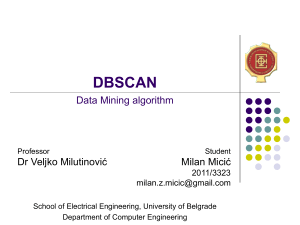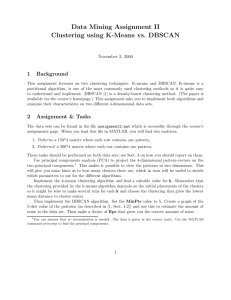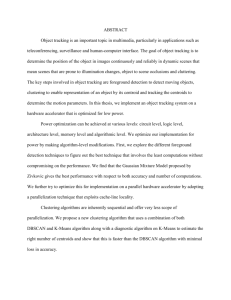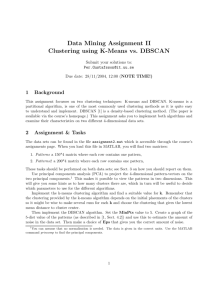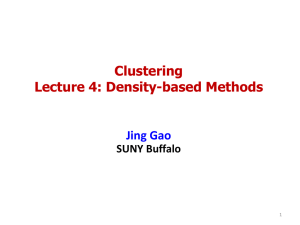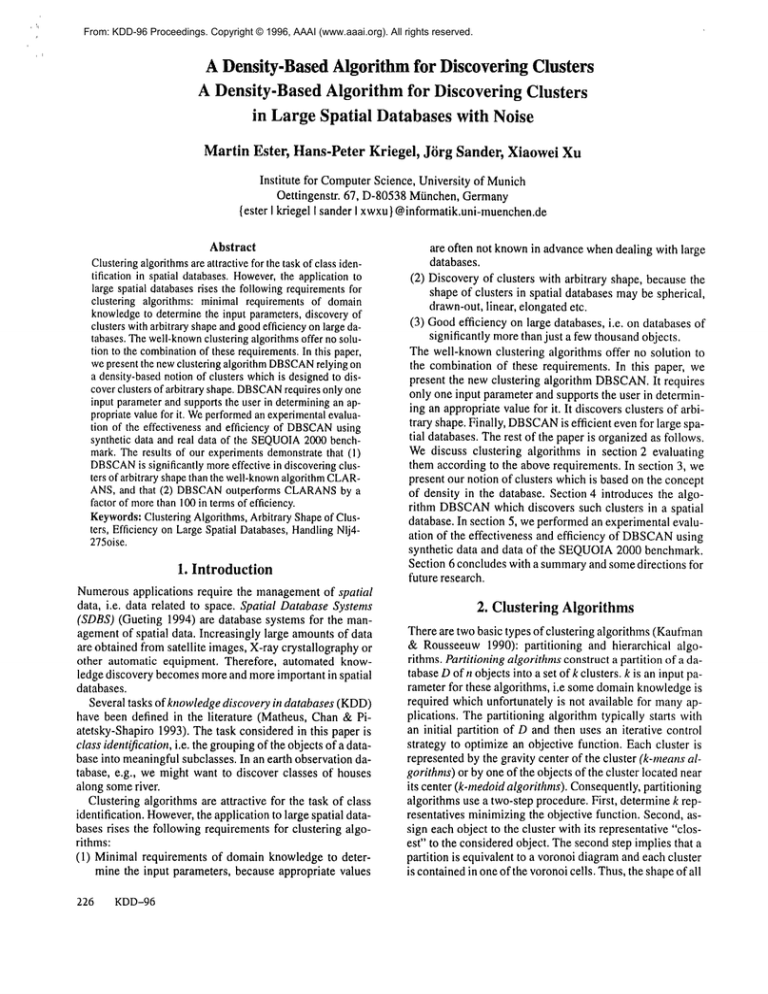
From: KDD-96 Proceedings. Copyright © 1996, AAAI (www.aaai.org). All rights reserved.
A Density-Based Algorithm for Discovering Clusters
in Large Spatial Databaseswith Noise
Martin Ester,
Hans-Peter Kriegel,
Jiirg
Sander, Xiaowei Xu
Institute for ComputerScience, University of Munich
Oettingenstr. 67, D-80538Miinchen, Germany
{ester I kriegel I sander I xwxu} @informatik.uni-muenchen.de
Abstract
Clusteringalgorithmsare attractive for the task of class identification in spatial databases.However,
the applicationto
large spatial databasesrises the followingrequirements
for
clustering algorithms: minimalrequirements of domain
knowledgeto determinethe input parameters,discoveryof
clusters witharbitrary shapeandgoodefficiencyonlarge databases. Thewell-known
clustering algorithmsoffer no solution to the combination
of these requirements.In this paper,
wepresent the newclustering algorithmDBSCAN
relying on
a density-basednotion of clusters whichis designedto discoverclusters of arbitrary shape. DBSCAN
requires only one
input parameterand supportsthe user in determiningan appropriatevalue for it. Weperformed
an experimental
evaluation of the effectiveness and efficiency of DBSCAN
using
synthetic data and real data of the SEQUOIA
2000benchmark.Theresults of our experimentsdemonstratethat (1)
DBSCAN
is significantly moreeffective in discoveringclusters of arbitrary shapethan the well-known
algorithmCLARANS,and that (2) DBSCAN
outperforms CLARANS
by
factor of morethan 100in termsof efficiency.
Keywords:
Clustering Algorithms,Arbitrary Shapeof Clusters, Efficiencyon LargeSpatial Databases,HandlingNlj4275oise.
1. Introduction
Numerousapplications require the managementof spatial
data, i.e. data related to space. Spatial DatabaseSystems
(SDBS)(Gueting 1994) are database systems for the managementof spatial data. Increasingly large amountsof data
are obtained fromsatellite images, X-ray crystallography or
other automatic equipment. Therefore, automated knowledge discovery becomesmore and more important in spatial
databases.
Several tasks of knowledgediscovery in databases (KDD)
have been defined in the literature (Matheus, Chan&Piatetsky-Shapiro 1993). The task considered in this paper is
class identification, i.e. the groupingof the objects of a database into meaningfulsubclasses. In an earth observation database, e.g., we might want to discover classes of houses
along someriver.
Clustering algorithms are attractive for the task of class
identification. However,
the application to large spatial databases rises the following requirementsfor clustering algorithms:
(1) Minimal requirements of domain knowledge to determinethe input parameters, because appropriate values
226
KDD-96
are often not knownin advancewhendealing with large
databases.
(2) Discoveryof clusters with arbitrary shape, because the
shapeof clusters in spatial databases maybe spherical,
drawn-out,linear, elongatedetc.
(3) Goodefficiency on large databases, i.e. on databases of
significantly morethan just a fewthousandobjects.
The well-knownclustering algorithms offer no solution to
the combination of these requirements. In this paper, we
present the new clustering algorithm DBSCAN.
It requires
only one input parameterand supports the user in determining an appropriatevalue for it. It discoversclusters of arbitrary shape. Finally, DBSCAN
is efficient evenfor large spatial databases. The rest of the paper is organizedas follows.
Wediscuss clustering algorithms in section 2 evaluating
them according to the above requirements. In section 3, we
present our notion of clusters whichis based on the concept
of density in the database. Section 4 introduces the algorithm DBSCAN
which discovers such clusters in a spatial
database. In section 5, we performedan experimentalevaluation of the effectiveness and efficiency of DBSCAN
using
synthetic data and data of the SEQUOIA
2000 benchmark.
Section 6 concludes with a summaryand somedirections for
future research.
2. Clustering
Algorithms
There are two basic types of clustering algorithms (Kaufman
& Rousseeuw1990): partitioning and hierarchical algorithms. Partitioningalgorithmsconstruct a partition of a database D ofn objects into a set ofk clusters, k is an input parameter for these algorithms, i.e somedomainknowledgeis
required whichunfortunately is not available for manyapplications. The partitioning algorithmtypically starts with
an initial partition of Dand then uses an iterative control
strategy to optimize an objective function. Eachcluster is
representedby the gravity center of the cluster (k-meansalgorithms)or by one of the objects of the cluster located near
its center (k-medoidalgorithms). Consequently,partitioning
algorithmsuse a two-step procedure. First, determinek representatives minimizingthe objective function. Second,assign each object to the cluster with its representative "closest" to the consideredobject. Thesecondstep implies that a
partition is equivalent to a voronoidiagramand each cluster
is containedin oneof the voronoicells. Thus,the shapeof all
clusters found by a partitioning algorithmis convexwhichis
veryrestrictive.
Ng & Han (1994) explore partitioning algorithms for
KDDin spatial databases. An algorithm called CLARANS
(Clustering Large Applications based on RANdomized
Search) is introduced which is an improvedk-medoidmethod. Compared to former k-medoid algorithms, CLARANS
is moreeffective and moreefficient. Anexperimentalevaluation indicates that CLARANS
runs efficiently on databases
of thousands of objects. Ng&Han(1994) also discuss methods to determinethe "natural" numberknat of clusters in a
database. They propose to run CLARANS
once for each k
from2 to n. For each of the discovered clusterings the silhouette coefficient (Kaufman&Rousseeuw1990) is calculated, and finally, the clustering with the maximum
silhouette coefficient is chosen as the "natural" clustering.
Unfortunately, the run time of this approachis prohibitive
for large n, because it implies O(n) calls of CLARANS.
CLARANS
assumesthat all objects to be clustered can reside in main memoryat the same time which does not hold
for large databases. Furthermore, the run time of CLARANS
is prohibitive on large databases. Therefore, Ester, Kriegel
&Xu(1995) present several focusing techniques which address both of these problemsby focusing the clustering process on the relevant parts of the database.First, the focus is
small enough to be memoryresident and second, the run
time of CLARANS
on the objects of the focus is significantly less than its run time on the wholedatabase.
Hierarchical algorithms create a hierarchical decomposition of D. The hierarchical decompositionis represented by
a dendrogram,a tree that iteratively splits D into smaller
subsets until each subset consists of only one object. In such
a hierarchy, each node of the tree represents a cluster of D.
The dendrogramcan either be created from the leaves up to
the root (agglomerativeapproach)or from the root downto
the leaves (divisive approach)by mergingor dividing clusters at eachstep. In contrast to partitioning algorithms,hierarchical algorithmsdo not needk as an input. However,a termination condition has to be defined indicating whenthe
mergeor division process should be terminated. One example of a termination condition in the agglomerativeapproach
is the critical distance Dmi
n betweenall the clusters of Q.
So far, the mainproblemwith hierarchical clustering algorithmshas been the difficulty of deriving appropriate panrameters for the termination condition, e.g. a value of Dmi
whichis small enoughto separate all "natural" clusters and,
at the sametime large enoughsuch that no cluster is split into
twoparts. Recently,in the area of signal processingthe hierarchical algorithm Ejcluster has been presented (Garcfa,
Fdez-Valdivia, Cortijo &Molina1994) automatically deriving a terminationcondition. Its key idea is that twopoints belong to the samecluster if you can walk fromthe first point
to the secondone by a "sufficiently small" step. Ejcluster
follows the divisive approach. It does not require any input
of domain knowledge. Furthermore, experiments show that
it is very effective in discovering non-convexclusters. However, the computationalcost of Ejcluster is O(n2) due to the
distance calculation for each pair of points. This is acceptable for applications such as character recognition with
moderatevalues for n, but it is prohibitive for applicationson
large databases.
Jain (1988) explores a density based approach to identify
clusters in k-dimensionalpoint sets. The data set is partitioned into a numberof nonoverlappingcells and histograms
are constructed. Cells with relatively high frequencycounts
of points are the potential cluster centers and the boundaries
betweenclusters fall in the "valleys" of the histogram. This
methodhas the capability of identifying clusters of any
shape. However,the space and run-time requirements for
storing and searching multidimensional histograms can be
enormous.Even if the space and run-time requirements are
optimized, the performance of such an approach crucially
dependson the size of the cells.
3. A Density Based Notion of Clusters
Whenlooking at the sample sets of points depicted in
figure 1, we can easily and unambiguously
detect clusters of
points and noise points not belongingto any of those clusters.
...:-’.".’"-...-:~
.
¯ .-,. ..:,,
., ,..-:.,..,~.,.:.
.. :::i-\"."’.,.:~:
..,,¯o
¯o,..°
°lo~,
~,
¯ - ,;~.:.:~
.°’-l" .,...
~’
..~,,:’.;t"""
:’:::
.:::;::."
database 3
database 1
database 2
figure 1: Sampledatabases
The main reason why we recognize the clusters is that
within each cluster wehave a typical density of points which
is considerably higher than outside of the cluster. Furthermore, the density within the areas of noise is lowerthan the
density in any of the clusters.
In the following, wetry to formalizethis intuitive notion
of "clusters" and "noise" in a database D of points of some
k-dimensionalspace S. Note that both, our notion of clusters
and our algorithm DBSCAN,
apply as well to 2D or 3D Euclidean space as to some high dimensional feature space.
Thekey idea is that for each point of a cluster the neighborhood of a given radius has to contain at least a minimum
numberof points, i.e. the density in the neighborhoodhas to
exceed somethreshold. The shape of a neighborhoodis determined by the choice of a distance function for two points
p and q, denoted by dist(p,q). For instance, whenusing the
Manhattandistance in 2Dspace, the shape of the neighborhoodis rectangular. Note, that our approachworkswith any
distance function so that an appropriate function can be chosen for somegiven application. For the purposeof proper visualization, all exampleswill be in 2Dspace using the Euclidean distance.
Definition 1: (Eps-neighborhood of a point) The Epsneighborhoodof a point p, denoted by NEps(P),is defined
NEps(P)= {q E DI dist(p,q) _< Eps}.
A naive approachcould require for each point in a cluster
that there are at least a minimum
number(MinPts) of points
in an Eps-neighborhoodof that point. However,this apSp~,ml, Text, & Multimedia
227
proachfails becausethere are two kinds of points in a cluster, points inside of the cluster (core points) and points on the
border of the cluster (border points). In general, an Epsneighborhoodof a border point contains significantly less
points than an Eps-neighborhood
of a core point. Therefore,
we wouldhave to set the minimum
numberof points to a relatively lowvalue in order to include all points belongingto
the samecluster. This value, however,will not be characteristic for the respectivecluster - particularlyin the presenceof
noise. Therefore,we require that for every point p in a cluster C there is a point q in C so that p is inside of the Epsneighborhood of q and NEps(q) contains at least MinPts
points. Thisdefinition is elaboratedin the following.
Definition2: (directly density-reachable)A point p is directly density-reachablefroma point q wrt. Eps, MinPtsif
1) p @NEps(q)
2) INEps(q)l> MinPts(core point condition).
Obviously,directly density-reachable is symmetricfor pairs
of core points. In general, however,it is not symmetricif one
core point and one border point are involved. Figure 2 shows
the asymmetriccase.
p:b0rdetp0mt
q: cQrepomt
¯
* ¯ ¯
¯
¯
q
reachable/r~m q
¯
*
*
*"
¯
* q not c~e.r-tly d~sltyreachable from p
figure 2: core points and borderpoints
Definition 3: (density-reachable) A point p is densityreachablefrom a point q wrt. Eps and MinPtsif there is a
chain of points Pl ..... Pn, Pl = q, Pn = P such that Pi+l is directly density-reachablefrom Pi.
Density-reachability is a canonical extension of direct
density-reachability.This relation is transitive, but it is not
symmetric. Figure 3 depicts the relations of somesample
points and, in particular, the asymmetriccase. Althoughnot
symmetricin general, it is obviousthat density-reachability
is symmetricfor core points.
Twoborder points of the samecluster C are possibly not
density reachable from each other because the core point
condition might not hold for both of them. However,there
must be a core point in C from whichboth border points of C
are density-reachable. Therefore, we introduce the notion of
density-connectivity which covers this relation of border
points.
Definition 4: (density-connected) A point p is densityconnectedto a point q wrt. Epsand MinPtsif there is a point
o such that both, p and q are density-reachable from o wrt.
Eps and MinPts.
Density-connectivityis a symmetricrelation. For density
reachablepoints, the relation of density-connectivityis also
reflexive(c.f. figure 3).
Now,we are able to define our density-based notion of a
cluster. Intuitively, a cluster is definedto be a set of densityconnected points which is maximalwrt. density-reachability. Noisewill be defined relative to a given set of clusters.
Noiseis simplythe set of points in D not belongingto any of
its clusters.
228
KDD-96
p de..m~
rear.,l~lef~rnq
rtachablefi’~mp
¯
.i) ¯
¯
..~.
¯
¯
¯
t~)
¯
p
~’i
p lind q de.allly’l~m~ectedto
* ¯ , ,..~_.~....~j
figure 3: density-reachabHity and density-connectivity
Definition 5: (cluster) Let D be a database of points.
cluster C wrt. Eps and MinPts is a non-emptysubset of D
satisfying the followingconditions:
1) V p, q: ifp E C and q is density-reachable fromp wrt.
Eps and MinPts, then q E C. (Maximality)
2) V p, q e C: p is density-connected
to q wrt. EPSand
MinPts. (Connectivity)
Definition6: (noise) Let Ct ..... Ck be the clusters of the
database D wrt. parametersEpsi and MinPtsi, i = 1 ..... k.
Thenwe define the noise as the set of points in the database
D not belongingto anycluster Ci , i.e. noise = {p E DI ’v’ i: p
Ci).
Notethat a cluster C wrt. Epsand MinPtscontains at least
MinPts points because of the following reasons. Since C
contains at least one point p, p must be density-connectedto
itself via somepoint o (whichmaybe equal to p). Thus,
least o has to satisfy the core point condition and, consequently, the Eps-Neighborhood
of o contains at least MinPts
points.
The following lemmataare important for validating the
correctness of our clustering algorithm. Intuitively, they
state the following. Given the parameters Eps and MinPts,
we can discover a cluster in a two-step approach. First,
choosean arbitrary point from the database satisfying the
core point condition as a seed. Second,retrieve all points
that are density-reachable fromthe seed obtaining the cluster containingthe seed.
Lemma
1: Let p be a point in D and INEps(p)l > MinPts.
Thenthe set O = {o I o E D and o is density-reachable from
p wrt. Eps and MinPts} is a cluster wrt. Epsand MinPts.
It is not obvious that a cluster C wrt. Eps and MinPtsis
uniquely determined by any of its core points. However,
each point in C is density-reachable from any of the core
points of C and, therefore, a cluster C contains exactly the
points which are density-reachable from an arbitrary core
point of C.
Lemma
2: Let C be a cluster wrt. Eps and MinPtsand let
p be any point in C with INEps(P)l > MinPts. ThenC equals
to the set O= {o I o is density-reachablefromp wrt. Epsand
MinPts}.
4. DBSCAN:
Density Based Spatial Clustering
of Applications with Noise
In this section, we present the algorithm DBSCAN
(Density
Based Spatial Clustering of Applications with Noise) which
is designedto discoverthe clusters and the noise in a spatial
database accordingto definitions 5 and 6. Ideally, we would
have to knowthe appropriate parameters Eps and MinPtsof
each cluster and at least one point from the respective cluster. Then,wecould retrieve all points that are density-reachable from the given point using the correct parameters. But
there is no easy wayto get this informationin advancefor all
clusters of the database. However,there is a simple and effective heuristic (presented in section section 4.2) to determinethe parameters Eps and MinPtsof the "thinnest", i.e.
least dense, cluster in the database. Therefore, DBSCAN
uses global values for Eps and MinPts, i.e. the samevalues
for all clusters. The density parameters of the "thinnest"
cluster are goodcandidatesfor these global parametervalues
specifying the lowest density whichis not considered to be
noise.
To find a cluster, DBSCAN
starts with an arbitrary point p
and retrieves all points density-reachable from p wrt. Eps
and MinPts.If p is a core point, this procedureyields a cluster wrt. Epsand MinPts(see Lemma
2). Ifp is a border point,
no points are density-reachable from p and DBSCAN
visits
the next point of the database.
Since we use global values for Eps and MinPts, DBSCAN
maymergetwo clusters according to definition 5 into one
cluster, if twoclusters of different densityare "close"to each
other. Let the distance betweentwo sets of points S
2 l and S
be definedas dist (S1, Sx) = min{dist(p,q) I p b q C$2}.
Then, two sets of points having at least the density of the
thinnest cluster will be separated fromeach other only if the
distance between the two sets is larger than Eps. Consequently, a recursive call of DBSCAN
maybe necessary for
the detected clusters with a higher value for MinPts.This is,
however,no disadvantage because the recursive application
of DBSCAN
yields an elegant and very efficient basic algorithm. Furthermore,the recursive clustering of the points of
a cluster is only necessaryunderconditions that can be easily detected.
In the following, we present a basic version of DBSCAN
omitting details of data types and generation of additional
informationabout clusters:
//
(SetOfPoints,
SetOfPoints
ClusterId
FOR
is
:=
i FROM
Point
IF
:=
UNCLASSIFIED
SetOfPoints.size
ClusterId
END
END
END;
DO
= UNCLASSIFIED
THEN
ExpandCluster(SetOfPoints,
ClusterId,
END
MinPts)
SetOfPoints.get(i);
Point.CiId
IF
Eps,
nextId(NOISE);
1 TO
:=
Eps,
MinPts)
Point,
THEN
nextId(ClusterId)
IF
IF
FOR
//
ExpandCluster
(SetOfPoints,
DBSCAN
SetOfPoints
is either the whole database or a discovered cluster ~oma p~vious run. Eps and M$nPgsare
the global density parameters determinedeither manuallyor
according to the heuristics presented in section 4.2. The
~ncfion SetOfPoints.
get( i ) returns the i-th element of SetOfPoints. The most important function
Point,
CiId,
Eps,
MinPts) : Boolean;
seeds : =SetOfPoints. regionQuery (Point, Eps )
IF seeds.size<MinPts
THEN // no core point
SetOfPoint. changeCl Id (Point, NOISE)
RETURN False;
// all points in seeds are densityELSE
// reachable from Point
SetOfpoints. changeCiIds ( seeds, C1 Id)
seeds .delete (Point)
WHILE seeds <> Empty
4.1 The Algorithm
DBSCAN
used by DBSCAN
is ExpandCluster which is presented below:
DO
currentP := seeds.first()
result := setofPoints.regionQuery(currentP,
Eps)
IF result.size
>= MinPts THEN
FOR i FROM 1 TO result.size
resultP := result.get(i)
DO
IF resultP. CiId
IN (UNCLASSIFIED,
NOISE} THEN
IF resultP.CiId
= UNCLASSIFIED
THEN
seeds, append (resultP)
END IF;
SetOfPoints. changeCiId ( resultP, CiId)
END IF; // UNCLASSIFIED
END FOR ;
or NOISE
END IF; // result.size
>= MinPts
seeds, delete (currentP)
END WHILE; // seeds <> Empty
RETURN True ;
END IF
END; // ExpandCluster
A
call
of
SetO fPoint s.regionQuery(Point,Eps) returnsthe Eps-Neighb0rho0d
Pointin SetOfPoints
as a listof points.
Regionqueriescan be supported efficiently by spatial access methods
such as R*-trees (Beckmannet al. 1990) which are assumed
to be available in a SDBS
for efficient processingof several
types of spatial queries (Brinkhoffetal. 1994). Theheight
an R*-tree is O(logn) for a database of n points in the worst
case and a query with a "small" query region has to traverse
only a limited numberof paths mthe R -tree. Since the EpsNeighborhoods are expected to be small compared to the
size of the wholedata space, the average run time complexity of a single region query is O(log n). For each of the
points of the database, we have at most one region query.
Thus, the average run time complexity of DBSCAN
is
O(n * log n).
The C1 Td (clusterId) of points which have been marked
to be NOISE
maybe changedlater, if they are density-reachable from someother point of the database. This happensfor
border points of a cluster. Thosepoints are not addedto the
seeds-list because we already knowthat a point with a
ClId of NOISEis not a core point. Addingthose points to
seeds wouldonly result in additional region queries which
wouldyield no new answers.
If twoclusters C! and C2 are very close to each other, it
might happenthat somepoint p belongs to both, C1 and
2. C
Thenp must be a border point in both clusters becauseotherwise C1 would be equal to C2 since we use global parameSpatial, Text, & Multimedia 229
ters. In this case, point p will be assignedto the cluster discoveredfirst. Exceptfromthese rare situations, the result of
DBSCAN
is independent of the order in which the points of
the database are visited due to Lemma
2.
4.2 Determining the Parameters Eps and MinPts
In this section, wedevelopa simplebut effective heuristic to
determine the parameters Eps and MinPtsof the "thinnest"
cluster in the database. This heuristic is basedon the following observation.Let d be the distance of a point p to its k-th
nearest neighbor, then the d-neighborhoodof p contains exactly k+l points for almost all points p. The d-neighborhood
of p contains more than k+l points only if several points
have exactly the samedistance d from p whichis quite unlikely. Furthermore,changingk for a point in a cluster does
not result in large changesofd. This only happensif the k-th
nearest neighborsofp for k= 1,2, 3 .... are located approximately on a straight line whichis in general not true for a
point in a cluster.
For a given k wedefine a function k-dist fromthe database
D to the real numbers, mappingeach point to the distance
fromits k-th nearest neighbor. Whensorting the points of the
databasein descendingorder of their k-dist values, the graph
of this function gives somehints concerningthe density distribution in the database. Wecall this graphthe sorted k-dist
graph. If we choose an arbitrary point p, set the parameter
Epsto k-dist(p) and set the parameterMinPtsto k, all points
with an equal or smaller k-dist value will be core points. If
we could find a threshold point with the maximalk-dist value in the "thinnest" cluster of D we wouldhave the desired
parametervalues. Thethreshold point is the first point in the
first "valley" of the sorted k-dist graph(see figure 4). All
points with a higher k-dist value ( left of the threshold) are
consideredto be noise, all other points (right of the threshold) are assigned to somecluster.
>
4-dist
threshold
point
’-.,.
noise
In general,it is verydifficult to detectthe first "valley"automatically, but it is relatively simple for a user to see this
valley in a graphical representation. Therefore, we propose
to follow an interactive approachfor determiningthe threshold point.
DBSCAN
needs two parameters, Eps and MinPts. However, our experimentsindicate that the k-dist graphs for k > 4
do not significantly differ fromthe 4-dist graphand, furthermore, they need considerably more computation. Therefore,
weeliminate the parameterMinPtsby setting it to 4 for all
databases (for 2-dimensionaldata). Wepropose the following interactive approach for determining the parameter Eps
of DBSCAN:
KDD-96
5. PerformanceEvaluation
In this section, we evaluate the performance of DBSCAN.
Wecompare it with the performance of CLARANS
because
this is the first and onlyclustering algorithmdesignedfor the
purpose of KDD.In our future research, we will perform a
comparisonwith classical density based clustering algorithms. Wehave implemented DBSCAN
in C++based on an
implementationof the R*-tree (Beckmannet al. 1990). All
experiments have been run on HP735 / 100 workstations.
Wehave used both synthetic sampledatabases and the database of the SEQUOIA
2000 benchmark.
To compare DBSCAN
with CLARANS
in terms of effectivity (accuracy), we use the three synthetic sampledatabases which are depicted in figure 1. Since DBSCAN
and
CLARANS
are clustering algorithms of different types, they
have no common
quantitative measureof the classification
accuracy. Therefore, we evaluate the accuracy of both algorithms by visual inspection. In sampledatabase 1, there are
four ball-shaped clusters of significantly differing sizes.
Sample database 2 contains four clusters of nonconvex
shape. In sampledatabase3, there are four clusters of different shapeand size with additional noise. To showthe results
of both clustering algorithms, we visualize each cluster by a
different color (see www
availability after section 6). Togive
CLARANS
some advantage, we set the parameter k to 4 for
these sample databases. The clusterings discovered by
CLARANS
are depicted in figure 5.
~ points
figure 4: sorted 4-dist graphfor sampledatabase3
230
¯ The system computes and displays the 4-dist graph for
the database.
¯ If the user can estimate the percentageof noise, this percentage is entered and the system derives a proposal for
the thresholdpoint fromit.
¯ Theuser either accepts the proposedthreshold or selects
another point as the threshold point. The4-dist value of
the threshold point is used as the Eps value for DBSCAN.
database 3
database 1
database 2
figure 5: Clusterings discovered by CLARANS
For DBSCAN,
we set the noise percentage to 0%for sample databases 1 and 2, and to 10%for sampledatabase 3, respectively. The clusterings discovered by DBSCAN
are depicted in figure 6.
DBSCAN
discovers all clusters (according to definition
5) and detects the noise points (according to definition
from all sample databases. CLARANS,
however, splits clusters if they are relatively large or if they are close to some
other cluster. Furthermore, CLARANS
has no explicit notion of noise. Instead, all points are assignedto their closest
medoid.
¯ . ~:.:..’..
° °.
damb~el
figure
.,
;:*
.’,:°
¯: :.:: :.’-"
..,.. "::?...:"
:~
and on real data of the SEQUOIA2000 benchmark. The resuits of these experiments demonstrate that DBSCAN
is significantly more effective in discovering clusters of arbitrary
shape than the well-known algorithm CLARANS.Furthermore, the experiments have shown that DBSCANoutperforms CLARANS
by a factor of at least 100 in terms of efficiency.
dabble2
6: Clusterings
dabble3
discovered
by DBSCAN
To test the efficiency
of DBSCANand CLARANS,we
use the SEQUOIA2000 benchmark data. The SEQUOIA
2000 benchmarkdatabase (Stonebraker et al. 1993) uses real
data sets ihat are representative of Earth Science tasks. There
are four types of data in the database: raster data, point data,
polygon data and directed graph data. The point data set contains 62,584 Californian names of landmarks, extracted
from the US Geological Survey’s Geographic Names Information System, together with their location. The point data
set occupies about 2.1 Mbytes. Since the run time of CLARANSon the whole data set is very high, we have extracted a
series of subsets of the SEQUIOA
2000 point data set containing from 2%to 20% representatives
of the whole set.
The run time comparison of DBSCANand CLARANSon
these databases is shownin table 1.
Table 1: run time in seconds
number of
points
1252
2503
3910
5213
6256
DBSCAN
3.1
6.7
11.3
16.0
17.8
CLARANS
758
3026
6845
11745
18029
number of
points
7820
8937
10426
12512
DBSCAN
24.5
28.2
32.7
41.7
CLARANS
29826
39265
60540
80638
The results of our experiments show that the run time of
DBSCAN
is slightly higher than linear in the number of
points. The run time of CLARANS,
however, is close to quadratic in the number of points. The results show that DBSCANoutperforms CLARANS
by a factor of between 250
and 1900 which grows with increasing size of the database.
6.
Conclusions
Clustering algorithms are attractive for the task of class identification in spatial databases. However,the well-known algorithms suffer from severe drawbacks when applied to
large spatial databases. In this paper, we presented the clustering algorithm DBSCAN
which relies on a density-based
notion of clusters. It requires only one input parameter and
supports the user in determining an appropriate value for it.
We performed a performance evaluation on synthetic data
Future research will have to consider the following issues.
First, we have only considered point objects. Spatial databases, however, may also contain extended objects such as
polygons. Wehave to develop a definition of the density in
an Eps-neighborhood in polygon databases for generalizing
DBSCAN.Second, applications
of DBSCANto high dimensional feature spaces should be investigated. In particular, the shape of the k-dist graph in such applications has to
be explored.
WWWAvailability
A version of this paper in larger font, with large figures and
clusterings in color is available under the following URL:
http : //www. dbs. informatik,uni-muenchen,de/
dbs/projec t/publikat ionen/veroef fent i ichungen. html.
References
BeckmannN., Kriegel H.-P., Schneider R, and Seeger B. 1990. The
R*-tree: An Efficient and Robust Access Methodfor Points and
Rectangles, Proc. ACMSIGMOD
Int. Conf. on Managementof
Data, Atlantic City, NJ, 1990, pp. 322-331.
Brinkhoff T., Kriegel H.-R, Schneider R., and Seeger B. 1994
Efficient Multi-Step Processing of Spatial Joins, Proc. ACM
SIGMOD
Int. Conf. on Managementof Data, Minneapolis, MN,
1994, pp. 197-208.
Ester M., Kriegel H.-P., and XuX. 1995. A Database Interface for
Clustering in Large Spatial Databases, Proc. 1st Int. Conf. on
KnowledgeDiscovery and Data Mining, Montreal, Canada, 1995,
AAAIPress, 1995.
Garcfa J.A., Fdez-ValdiviaJ., Cortijo E J., and MolinaR. 1994. A
DynamicApproachfor Clustering Data. Signal Processing, Vol. 44,
No. 2, 1994, pp. 18t-196.
Gueting R.H. 1994. An Introduction to Spatial Database Systems.
The VLDBJournal 3(4): 357°399.
Jain Anil K. 1988. Algorithmsfor Clustering Data. Prentice Hall.
KaufmanL., and RousseeuwRJ. 1990. Finding Groups#~ Data: an
Introduction to Cluster Analysis. John Wiley&Sons.
MatheusC.J.; ChanP.K.; and Piatetsky-Shapiro G. 1993. Systems
for KnowledgeDiscovery in Databases, 1EEETransactions on
Knowledgeand Data Engineering 5(6): 903-913.
Ng R.T., and Han J. 1994. Efficient and Effective Clustering
Methodsfor Spatial Data Mining, Proc. 20th Int. Conf. on Very
Large Data Bases, 144-155. Santiago, Chile.
Stonebraker M., Frew J., Gardels K., and Meredith J.1993. The
SEQUOIA2000 Storage Benchmark, Proc. ACMSIGMODInt.
Conf. on Managementof Data, Washington,DC, 1993, pp. 2-11.
Spatial,
Text, 6z Multimedia 231

